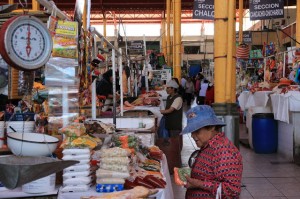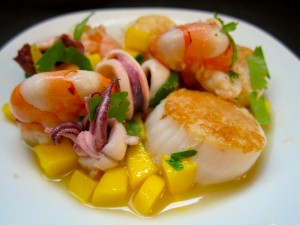 Food can tell us a lot about immigrant integration. Immigration transforms local food; immigrants, in turn, assimilate local food into their diets. Through the transformation of food, one can see how immigrants adapt and identify in the host society, as well as how they are identified and accepted by it.
Food can tell us a lot about immigrant integration. Immigration transforms local food; immigrants, in turn, assimilate local food into their diets. Through the transformation of food, one can see how immigrants adapt and identify in the host society, as well as how they are identified and accepted by it.
Japanese immigrants and their descendants in Peru, collectively called Nikkei, are a case in point. Long ambivalent about their identity, Nikkei Peruvians are comfortably at home in Peru today, as manifested by the emergence and proliferation of Nikkei food, or Cocina Nikkei, in Peru and elsewhere.
The emergence of a food genre
La Cocina Nikkei, broadly defined as Japanese and Peruvian fusion food, is at the forefront of the Peruvian gastronomic boom. Combining “key” Japanese ingredients, such as shoyu, miso and seafood, with Peruvian ají peppers, the cuisine features dishes such as Tiradido, thinly sliced raw fish served in a spicy sauce, and Inka Maki, sometimes called Samuray Maki or Kamikaze Maki, depending on what goes inside sushi roll wrapped typically in seaweed or sesame seeds.
Since Rodolfo Hinostroza, a Peruvian poet and a food writer, coined the term in the 1980s, Cocina Nikkei has been established as a genre of Peruvian cuisine, thanks largely to promoters, such as Gastón Acurio, Peru’s best-known chef and a major protagonist behind his country’s gastronomic boom since the 1990s. Over the last decades Nikkei restaurants have proliferated in number and gained visibility around the world with the advent of trendy restaurants owned by renowned chefs, including Gastón Acurio (who owns 37 restaurants in 11 countries altogether), Nobu Matsuhisa (with 28 restaurants around the world), and Ferrán and Albert Adrià (Barcelona).
This all happened in the context of Peru’s gastronomic revolution. The Peruvian capital has become a gastronomic mecca, reports The Economist (February 22, 2014), attracting 75,000 visitors every year solely for the purpose of gastronomic tourism. Accounting for 40% of foreigners traveling to Peru, food tourists spend, on average, US$130 in high-end restaurants every day they spend in Peru, writes Rachel Chase in a web magazine, Peru This Week (November 19, 2013). Overall, the food industry generates some 10% of Peru’s GDP today, according to the Chamber of Commerce of Lima.
Food as a national identity
Recognizing its potential, the Peruvian government actively promotes its food by attracting more tourists, exporting Peruvian products, and setting up Peruvian restaurants around the world. Peruvian cuisine is not simply regarded as a means for economic growth, however; it is promoted to market the country’s rich cultural diversity and traditions, as well as a tool to forge national unity among Peruvians. Gastón Acurio commented at Mistura, the largest international food festival in Latin America, held annually in Lima: “…by consolidating the place of Peruvian food in the world, (we) will instill pride in our local traditions and resources.” In a society long marked by cultural divides and social inequalities, food has emerged as a symbol of national unity and identity.
In this context, Nikkei food has become identified as a key component of Peruvian national cuisine. Nikkei food may have roots in Japanese cuisine. But it is quintessentially Peruvian and a new Peruvian invention, assert Mitsuharu Tsumura and Josefina Barrón in their recent cookbook, entitled Nikkei Es Peru (Nikkei Is Peru) (Telefónica 2013): “There is no such thing as Nikkei cuisine in Japan. Nikkei is Peruvian. It is in the DNA of our food.” The Peruvian media also feature Tsumura and other rising Nikkei star chefs, treating them as representatives of Peruvian gastronomy. Chef Tsumura, a Peruvian of Japanese descent, responds affirmatively in an interview featured by the Japanese Peruvian Association of Peru (APJ): “Nikkei cuisine does represent our national identity. It demonstrates that we can live together and happily!” (Kaikan, August 2011).
As Nikkei cuisine gains popularity in and outside of Peru, Nikkei Peruvian chefs, along with many other Peruvians of Japanese descent, feel accepted and proud of being Peruvian and having Japanese ancestry (Kaikan, March-April 2011). To them, the proliferation of Nikkei cuisine is a symbol of social acceptance and integration.
Once regarded as alien and unpalatable, Nikkei food, or Japanese food as it was known back then, is now in vogue and forms a key part of Peru’s national cuisine. Indeed, this once parochial food, consumed only by 23,000 or so immigrants who arrived from Japan between 1899 and 1930s, is now widely consumed and cooked not only by Nikkei but by all Peruvians; as an integral part of Peruvian national cuisine, the APJ (2011) proclaims, it represents “our country’s cultural diversity and tolerance” (Kaikan, October 2011).
Food as identity and power
Food is a powerful tool to cultivate an identity and integrate a population. Through the emergence of Nikkei cuisine, we see both Nikkei Peruvians’ efforts to nurture and validate their own identity and the nation’s strategy to unify its population. Although the rhetoric of “Peruvian national cuisine” incorporates all Peruvians, both rich and poor, including those of Japanese and indigenous origins, it nevertheless conceals inequality and hierarchy and the very power dynamics that produce the rhetoric. While food is indicative of immigrants’ integration, it also is a prime vehicle to analyze who has the power and resources to define cuisine—and for whom and for what.
